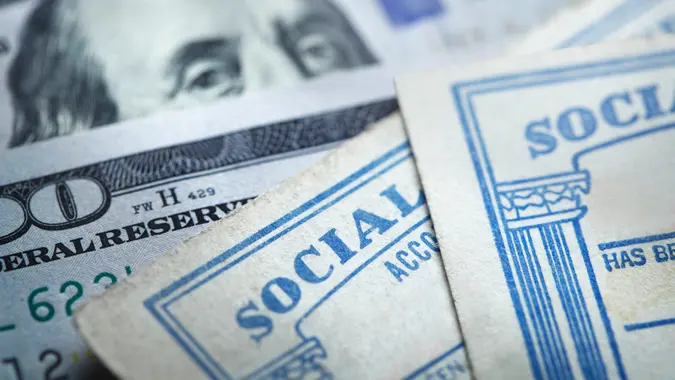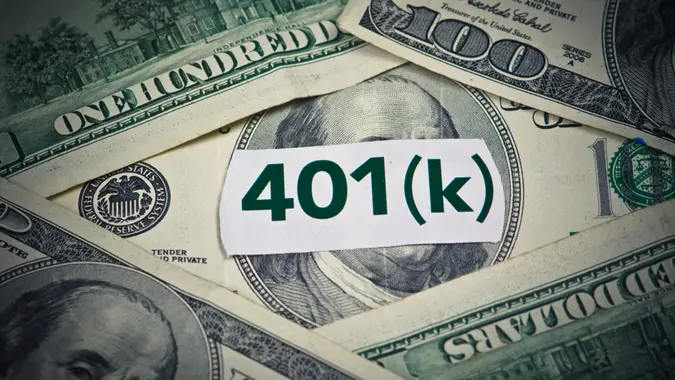More Than 1 in 3 Americans Will Delay Retirement Due to Financial Challenges — Here’s Why

Commitment to Our Readers
GOBankingRates' editorial team is committed to bringing you unbiased reviews and information. We use data-driven methodologies to evaluate financial products and services - our reviews and ratings are not influenced by advertisers. You can read more about our editorial guidelines and our products and services review methodology.

20 Years
Helping You Live Richer

Reviewed
by Experts

Trusted by
Millions of Readers
Saving for retirement is one of the most important financial moves you can make, but also one of the most challenging.
Federal Reserve research found that the average retirement savings for Americans ages 65 to 74 was $200,000 as of 2022, the most recent year data are available. That’s well below the $560,000-plus recommended by Fidelity based on its formula of saving about nine times your annual salary at age 65.
Because building an adequate next egg is so difficult, more than one in three U.S. adults (35%) have either delayed or intend to delay their retirement, according to a recent survey of 2,262 Americans conducted by New York Life.
Why Are People Delaying Retirement?
The New York Life survey revealed three main reasons people are delaying retirement: Insufficient savings (51% of respondents), inflation (46%) and the changing economic environment (32%).
The vast majority of Americans (92%) are concerned about current market conditions, particularly in terms of the following:
- Higher cost of living (63% of respondents)
- Rising cost of everyday expenses (55%)
- Saving for the future (46%)
More than half of respondents (53%) said they have revised their retirement strategy, with 23% saying they’re focused on paying down debt and 16% saying they’re working longer (16%) to meet their goals.
Here are some other survey highlights:
- Less than half (45%) of respondents have accounted for healthcare and long-term care expenses in their retirement planning.
- Most adults (60%) are “confident” they’ll have sufficient savings to last through retirement, though nearly one-third (32%) are unsure whether they’ll outlive their assets.
“Planning for retirement and managing decumulation is increasingly complex given macroeconomic conditions, along with rising costs associated with healthcare, caregiving and long-term care,” Jessica Ruggles, corporate vice president of financial wellness at New York Life, said in a press release.
“Thoughtful, informed financial guidance — whether self-directed or supported by a professional — can play a critical role in helping people test their financial assumptions and navigate evolving challenges.”
Generational Differences
The New York Life survey found that millennials and baby boomers (43% each) are the most likely to report having retirement savings. Gen Xers (38%) and Gen Zers (36%) lag slightly behind.
Nearly two-thirds of millennials (64%) have voiced “at least some confidence” in their ability to save adequately for retirement, versus only 50% of Gen Xers.
Separate research from the TransAmerica Center for Retirement Studies also found vast age-group differences when it comes to retirement goals and savings.
Here are some of the highlights from its 25th Annual TransAmerica Retirement Survey, released on Oct. 21, 2025:
- 20 to 29 years old: $300,000 is the median amount they need to feel financially secure in retirement, while their median estimated savings are $43,000 in household retirement accounts.
- 30 to 39: $500,000 is the median amount they need to feel financially secure in retirement, while their median estimated savings are $54,000 in household retirement accounts.
- 40 to 49: $500,000 is the median amount they need to feel financially secure in retirement, while their median estimated savings are $73,000 in household retirement accounts.
- 50 to 59: $600,000 is the median amount they need to feel financially secure in retirement, while their median estimated savings are $112,000 in household retirement accounts.
- 60 to 69: $277,000 is the estimated median amount saved by those who are not already retired, while $203,000 is the estimated median amount retirees have in total household savings.
More From GOBankingRates
 Written by
Written by  Edited by
Edited by 
























